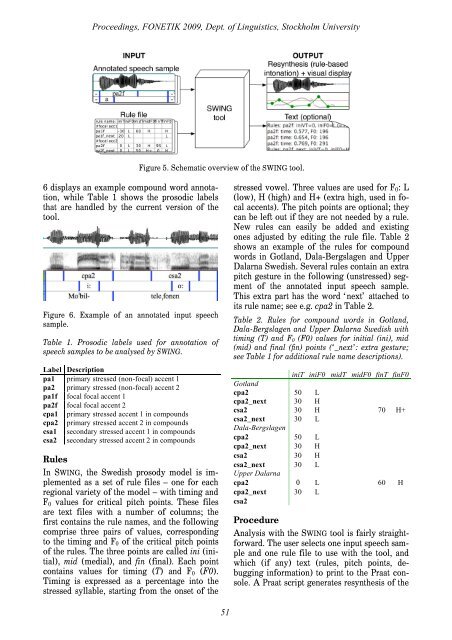Proceedings Fonetik 2009 - Institutionen för lingvistik
Proceedings Fonetik 2009 - Institutionen för lingvistik
Proceedings Fonetik 2009 - Institutionen för lingvistik
You also want an ePaper? Increase the reach of your titles
YUMPU automatically turns print PDFs into web optimized ePapers that Google loves.
<strong>Proceedings</strong>, FONETIK <strong>2009</strong>, Dept. of Linguistics, Stockholm UniversityFigure 5. Schematic overview of the SWING tool.6 displays an example compound word annotation,while Table 1 shows the prosodic labelsthat are handled by the current version of thetool.Figure 6. Example of an annotated input speechsample.Table 1. Prosodic labels used for annotation ofspeech samples to be analysed by SWING.Label Descriptionpa1 primary stressed (non-focal) accent 1pa2 primary stressed (non-focal) accent 2pa1f focal focal accent 1pa2f focal focal accent 2cpa1 primary stressed accent 1 in compoundscpa2 primary stressed accent 2 in compoundscsa1 secondary stressed accent 1 in compoundscsa2 secondary stressed accent 2 in compoundsRulesIn SWING, the Swedish prosody model is implementedas a set of rule files – one for eachregional variety of the model – with timing andF 0 values for critical pitch points. These filesare text files with a number of columns; thefirst contains the rule names, and the followingcomprise three pairs of values, correspondingto the timing and F 0 of the critical pitch pointsof the rules. The three points are called ini (initial),mid (medial), and fin (final). Each pointcontains values for timing (T) and F 0 (F0).Timing is expressed as a percentage into thestressed syllable, starting from the onset of thestressed vowel. Three values are used for F 0 : L(low), H (high) and H+ (extra high, used in focalaccents). The pitch points are optional; theycan be left out if they are not needed by a rule.New rules can easily be added and existingones adjusted by editing the rule file. Table 2shows an example of the rules for compoundwords in Gotland, Dala-Bergslagen and UpperDalarna Swedish. Several rules contain an extrapitch gesture in the following (unstressed) segmentof the annotated input speech sample.This extra part has the word ‘next’ attached toits rule name; see e.g. cpa2 in Table 2.Table 2. Rules for compound words in Gotland,Dala-Bergslagen and Upper Dalarna Swedish withtiming (T) and F 0 (F0) values for initial (ini), mid(mid) and final (fin) points (‘_next’: extra gesture;see Table 1 for additional rule name descriptions).iniT iniF0 midT midF0 finT finF0Gotlandcpa2 50 Lcpa2_next 30 Hcsa2 30 H 70 H+csa2_next 30 LDala-Bergslagencpa2 50 Lcpa2_next 30 Hcsa2 30 Hcsa2_next 30 LUpper Dalarnacpa2 0 L 60 Hcpa2_next 30 Lcsa2ProcedureAnalysis with the SWING tool is fairly straightforward.The user selects one input speech sampleand one rule file to use with the tool, andwhich (if any) text (rules, pitch points, debugginginformation) to print to the Praat console.A Praat script generates resynthesis of the51
















